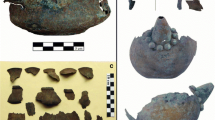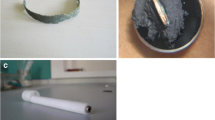Abstract
Reference Cu-based alloy with chemical composition and micro-chemical structure similar to that of ancient alloys has been used for carrying out the artificial long-term degradation test based on chloride enriched soil (chemical + soil) degradation. The results show that such degradation procedure produces natural like “patinas” as the ones grown on archaeological artefacts, from a chemical, structural and micro-morphological point of view. Glow discharge plasma technique has been employed for the treatment of the as-corroded bronze coupons. The gradual elimination of chloride-containing corrosion products in favour of the formation of more stable species and even the complete reduction back to copper has been observed. The chemical and metallurgical features have been determined by combined use of different analytical techniques such as scanning electron microscopy with energy dispersive X-ray micro-analysis (SEM-EDS), X-ray diffraction (XRD) and optical microscopy.












Similar content being viewed by others
References
Scott DA (1990) JAIC 29(2):193–206
Veprek V, Eckmann C, Elmer J (1988) Plasma Chem Plasma Process 8(4):445–465
Kotzamanidi I, Sarris EM, Vassiliou P, Kollia C, Kanias GD, Varoufakis GJ, Filippakis SE (1999) Br Corros J 34(4):285–291
Kotzamanidi I, Anastasiadis A, Filippaki L, Filippakis SE, Vassiliou P, Sarris EM (2002) Anticorrosion Methods & Materials 49(4):256–263
Ingo GM et al (2005) European Material Research Society Spring Meeting—Symposium Q (Materials Science and Cultural Heritage), Strasbourg (May 31–June 2, 2005).
Casaletto MP, De Caro T, Ingo GM, Riccucci C (2006) Appl Phys A 83:617–622
JCPDS Powder Diffraction File, Int. Centre for Diffraction Data, Swarthmore
Tylecote RT (1979) J Archaeol Sci 6:345–368
Scott AD (1985) Stud Conserv 30:49–57
Robbiola L, Blengino JM, Fiaud C (1988) Corros Sci 40:2083–2111
Lucey V (1972) Br Corros J 7:36–41
MacLeod ID (1987) Stud Conserv 32:25–40
Samara Cl (2007) PhD Thesis (unpublished), N.T.U.A. School of Chemical Engineering. pp. 373-374
Kotzamanidou E, Filippaki E, Sakarikou G, Filippakis S, Kollia K, Vassiliou P (2001) Archaeometry issues in greek prehistory and antiquity, Athens pp. 459-467 (in Greek)
Author information
Authors and Affiliations
Corresponding author
Rights and permissions
About this article
Cite this article
Novakovic, J., Papadopoulou, O., Vassiliou, P. et al. Plasma reduction of bronze corrosion developed under long-term artificial ageing. Anal Bioanal Chem 395, 2235–2244 (2009). https://doi.org/10.1007/s00216-009-3015-2
Received:
Revised:
Accepted:
Published:
Issue Date:
DOI: https://doi.org/10.1007/s00216-009-3015-2




